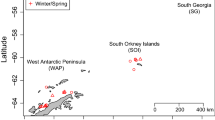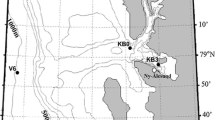Abstract
To better understand the trophic role of ctenophores in Antarctica during austral fall and winter, a major species of cydippid ctenophore, Callianira antarctica, was collected during April/May (fall) and August/September (winter) 2002 in the vicinity of Marguerite Bay. Lipid content, lipid classes, fatty acids, fatty alcohols and sterols were analyzed in animals, together with lipid biomarkers in krill and copepod species representing potential ctenophore prey. Lipid content in ctenophores collected in winter was slightly higher than from animals in fall (4.8 and 3.5% of dry weight, respectively). Polar lipids were the dominant lipid class in ctenophores, accounting for over half of the lipid content, with significant amounts of free fatty alcohols (more than 10% of total lipid content) detected. Lipid-class composition, however, differed significantly between seasons, with significant amounts of neutral lipid (wax esters and triacylglycerols) only detected in animals from fall. Although the dominant lipid classes in ctenophores varied between fall and winter, individual lipids (i.e., fatty acids, alcohols and sterols) showed only minor changes between seasons. Specifically, long-chain polyunsaturated fatty acids [20:5(n-3) and 22:6(n-3)] found in high abundance in larval krill were also elevated in ctenophores collected in winter. Very high amounts of monounsaturated fatty alcohols, particularly 20:1(n-9) and 22:1(n-11), known to be important components of wax esters in calanoid copepods, were also observed. Multivariate analysis using the suite of lipids found indicated that copepods are an important diet item for ctenophores in the study area. Results further suggest that C. antarctica feed actively year-round, with larval krill providing a food resource during austral winter.


Similar content being viewed by others
References
Albers CS, Kattner G, Hagen W (1996) The compositions of wax esters, triacylglycerols and phospholipids in Arctic and Antarctic copepods: evidence of energetic adaptations. Mar Chem 55:347–358
Båmstedt U (1998) Trophodynamics of Pleurobrachia pileus (Ctenophora, Cydippida) and ctenophore summer occurrence off the Norwegian northwest coast. Sarsia 83:169–181
Barrett SM, Volkman JK, Dunstan GA (1995) Sterols of 14 species of marine diatoms (Baccillariophyta). J Phycol 31:360–369
Bottino NR (1974) The fatty acids of Antarctic phytoplankton and euphausiids: fatty acid exchange among trophic levels of the Ross Sea. Mar Biol 27:197–204
Clark A (1984) Lipid content and composition of Antarctic krill Euphausia superba Dana. J Crust Biol 4:285–294
Clarke A, Holmes LJ, Gore DJ (1992) Proximate and elemental composition of gelatinous zooplankton from the Southern Ocean. J Exp Mar Biol Ecol 155:55–68
Cripps GC, Atkinson A (2000) Fatty acid composition as an indicator of carnivory in Antarctic krill, Euphausia superba. Can J Fish Aquat Sci 57:31–37
Daly KL (1990) Overwintering development, growth, and feeding of larval Euphausia superba in the Antarctic marginal ice zone. Limnol Oceanogr 35:1564–1576
Daly KL (2004) Overwintering growth and development of larval Euphausia superba: an interannual comparison under varying environmental conditions west of the Antarctic Peninsula. Deep Sea Res II (in press)
Daly KL, Macaulay MC (1991) The influence of physical and biological mesoscale dynamics on the seasonal distribution and behavior of Euphausia superba in the Antarctic marginal ice zone. Mar Ecol Prog Ser 79:37–66
Falk-Petersen S, Sargent JR, Lønne OJ, Timofeev S (1999) Functional biodiversity of lipids in Antarctic zooplankton: Calanoides acutus, Calanus propinquus, Thysanoessa macrura and Euphausia crystallorophias. Polar Biol 21: 37–47
Falk-Petersen S, Dahl TM, Scott CL, Sargent JR, Gulliksen B, Kwasniewski S, Hop H, Millar R-M (2002) Lipid biomarkers and trophic linkages between ctenophores and copepods in Svalbard waters. Mar Ecol Prog Ser 227:187–194
Frank KT (1986) Ecological significance of the ctenophore Pleurobrachia pileus off southwestern Nova Scotia. Can J Fish Aquat Sci 43:211–222
Fraser AJ, Taggart CT (1988) Thin-layer chromatography-flame ionization detection calibration with natural and synthetic standards. J Chromatogr 439: 404–407
Fukuda Y, Naganuma T (2001) Potential dietary effects on the fatty acid composition of the common jellyfish Aurelia aurita. Mar Biol 138:1029–1035
Goad LJ (1978) The sterols of marine invertebrates: composition, biosynthesis and metabolites. In: Scheuer PJ (ed) Marine natural products, vol 2. Academic, New York, pp 74–172
Graeve M, Dauby P, Scailteur Y (2001) Combined lipid, fatty acid and digestive tract content analyses: a penetrating approach to estimate feeding modes of Antarctic amphipods. Polar Biol 24:853–862
Hagen W (1989) On the significance of lipids in Antarctic zooplankton. Can Trans Fish Aquat Sci 5458:1–149
Hagen W, Van Vleet ES, Kattner G (1996) Seasonal lipid storage as overwintering strategy of Antarctic krill. Marine Ecology Progress Series 134:85-89
Hagen W, Kattner G, Graeve M (1993) Calanoides acutus and Calanus propinquus, Antarctic copepods with different lipid storage modes via wax esters or triacyglycerols. Mar Ecol Prog Ser 97:135–142
Hagen W, Kattner G, Terbruggen A, Van Vleet ES (2001) Lipid metabolism of the Antarctic krill Euphausia superba and its ecological implications. Mar Biol 139(1):95–104
Hamner WM, Hamner PP (2000) Behavior of Antarctic krill (Euphausia superba): schooling, foraging, and antipredatory behavior. Can J Fish Aquat Sci 57:192–202
Hamner WM, Hamner PP, Obst BS (1989) Field observations on the ontogeny of schooling of Euphausia superba furciliae and its relationship to ice in Antarctic waters. Limnol Oceanogr 34:451–456
Harvey HR (1994) Fatty acids and sterols as source markers of organic matter in sediments of the North Carolina continental slope. Deep Sea Res II 41:783–796
Harvey HR, McManus GB (1991) Marine ciliates as a widespread source of tetrahymanol and hopan-3-β-ol in sediments. Geochem Cosmochim Acta 55:3387–3390
Harvey HR, Eglinton G, O‘Hara SCM, Corner EDS (1987) Biotransformation and assimilation of dietary lipids by Calanus feeding on a dinoflagellate. Geochem Cosmochim Acta 51:3030–3041
Joseph JD (1979) Lipid composition of marine and estuarine invertebrates: porifera and cnidaria. Prog Lipid Res 18:1–30
Ju S-J, Harvey HR (2004) Lipids as markers of nutritional condition and diet in the Antarctic krill, Euphausia superba and Euphausia crystallorophias during austral winter. Deep Sea Res II (in press)
Ju S-J, Kucklick JR, Kozlova T, Harvey HR (1997) Lipid accumulation and fatty acid composition during maturation of three pelagic fish species in Lake Baikal. J Great Lake Res 23:241–253
Kariotoglou DM, Mastronicolis SK (2001) Sphingophosphonolipids, phospholipids, and fatty acids from Aegean jellyfish Aurelian aurita. Lipids 36:1255–1264
Kattner G, Hagen W (1995) Polar herbivorous copepods—different pathways in lipid biosynthesis. ICES J Mar Sci 52:329–335
Kattner G, Hagen W (1998) Lipid metabolism of the Antarctic euphausiid Euphausia crystallorophias and its ecological implication. Mar Ecol Prog Ser 170:203–213
Kattner G, Graeve M, Hagen W (1994) Ontogenetic and seasonal changes in lipid and fatty acid/alcohol compositions of the dominant Antarctic copepods Calanus propinquus, Calanoides acutus and Rhincalanus gigas. Mar Biol 118:637–644
Kaufmann RS, Fisher ER, Gill W, King AL, Laubacher M, Sullivan B (2003) Seasonal patterns in marcozooplankton/micronekton distribution, abundance, biomass and species diversity within Port Foster, Deception Island, Antarctica. Deep Sea Res II 50:1753–1763
Lancraft TM, Torres JJ, Hopkins TL (1989) Micronekton and macrozooplankton in the open waters near Antarctic ice edge zones (AMERIEZ 1983 and 1986). Polar Biol 9:225–233
Lancraft TM, Hopkins TL, Torres JJ, Donnelly J (1991) Oceanic micronektonic/macrozooplanktonic community structure and feeding in ice covered Antarctic waters during the winter (AMERIEZ 1988). Polar Biol 11:157–167
Larson RJ (1987) Trophic ecology of planktonic gelatinous predators in Saanich Inlet, British Columbia: diets and prey selection. J Plankton Res 9:811–820
Larson RJ, Harbison GR (1989) Source and fate of lipids in polar-gelatinous zooplankton. Arctic 42:339–346
Miller CB, Morgan CA, Prahl EG, Sparrow MA (1998) Storage lipids of the copepod Calanus finmarchicus from Georges Bank and the Gulf of Maine. Limnol Oceanogr 43:488–497
Mills CE (1995) Medusae, siphonophores, and ctenophores as planktivorous predators in changing global ecosystems. ICES J Mar Sci 52:575–581
Mühlebach A, Albers C, Kattner G (1999) Differences in the sterol composition of dominant Antarctic zooplankton. Lipids 34:45–51
Nelson MM, Phleger CF, Mooney BD, Nichols PD (2000) Lipids of gelatinous Antarctic zooplankton: Cnidaria and Ctenophora. Lipids 35:551–559
Nichols PD, Guckert JB, White DC (1986) Determination of monounsaturated fatty acid double-bond position and geometry for microbial monocultures and complex consortia by capillary GC-MS of their dimethyl disulphide adducts. J Microbiol Methods 5:49–55
Ohman MD (1997) On the determination of zooplankton lipid content and the occurrence of gelatinous copepods. J Plankton Res 19:1235–1250
Pagès F, White MG, Rodhouse PG (1996) Abundance of gelatinous carnivores in the nekton community of the Antarctic Polar Frontal Zone in summer 1994. Mar Ecol Prog Ser 141:139–147
Pakhomov EA (1989) Macroplankton distribution in the central part of the Indian sector of Antarctica during summer of 1984–1986. The Antarctic. Nauka, Moscow
Phleger CF, Nichols PD, Virtue P (1998) Lipids and trophodynamics of Antarctic zooplankton. Comp Biochem Physiol B 120:311–323
Reeve MR, Walter MA, Ikeda T (1978) Laboratory studies of ingestion and food utilization in lobate and tentaculate ctenophores. Limnol Oceanogr 23:740–751
Sargent JR, Falk-Petersen S (1981) Ecological investigations on the zooplankton community of Balsfjordon, northern Norway: lipids and fatty acids in Meganyctiphanes norvegica, Thysanoessa raschii and T. inermis during mid-winter. Mar Biol 62:131–137
Sargent JR, Henderson RJ (1986) Lipids. In: Corner EDS, O’Hara SCM (eds) The biological chemistry of marine copepods. Clarendon, Oxford, pp 59–164
Scolardi K, Daly KL, Pakhomov EA, Torres J (2004) Feeding ecology and metabolism of the Antarctic cydippid ctenophore, Callianira antarctica. MEPS (in review)
Shiganova TA, Bulgakova YV (2002) Effects of gelatinous plankton on Black Sea and Sea of Azov fish and their food resources. ICES J Mar Sci 57:641–648
Siferd TD, Conover RJ (1992) Natural history of ctenophores in the Resolute passage area of the Canadian High Arctic with special reference to Mertensia ovum. Mar Ecol Prog Ser 86:133–144
Stübing D, Hagen W, Schmict K (2003) On the use of lipid biomarkers in marine food web analyses: an experimental case study on the Antarctic krill, Euphausia superba. Limnol Oceanogr 48:1685–1700
Swanberg N, Båmstedt U (1991) Ctenophora in the Arctic: the abundance, distribution and predatory impact of the cydippid ctenophore Mertensia ovum (Fabricius) in the Barents Sea. Polar Res 10:507–524
Volkman JK, Nichols PD (1991) Applications of thin layer chromatography-flame ionization detection to the analysis of lipids and pollutants in marine and environmental samples. J Planar Chromatogr 4:19–26
Volkman JK, Everitt DA, Allen DI (1986) Some analyses of lipid classes in marine organisms, sediments and seawater using thin-layer chromatography-flame ionization detection. J Chromatogr 356:147–162
Acknowledgements
We thank the captain and crew of the R/V L.M. Gould and N.B. Palmer and technicians and personnel of Raytheon Polar services company for assistance with field collections and technical and travel support. Comments and suggestions by several reviewers improved the earlier version of the manuscript. We also thank Brenda Yates for help with manuscript preparation. This work was supported by the NSF through the Southern Ocean GLOBEC Program [OPP-9910043 (Harvey) and OPP-9910610 and OPP-0196489 (Daly)]. This is contribution no. 3776 of the University of Maryland Center for Environmental Science and contribution no. 447 for USGLOBEC program.
Author information
Authors and Affiliations
Corresponding author
Rights and permissions
About this article
Cite this article
Ju, SJ., Scolardi, K., Daly, K.L. et al. Understanding the trophic role of the Antarctic ctenophore, Callianira antarctica, using lipid biomarkers. Polar Biol 27, 782–792 (2004). https://doi.org/10.1007/s00300-004-0652-y
Received:
Revised:
Accepted:
Published:
Issue Date:
DOI: https://doi.org/10.1007/s00300-004-0652-y




